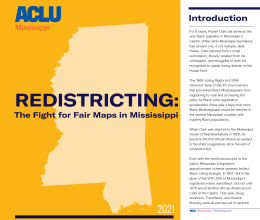
Redistricting FAQs
1. What is redistricting?
A.What is redistricting?
Redistricting is the process of redrawing the lines of districts from which public officials are elected. Redistricting takes place after each census and affects all jurisdictions that use districts, whether for members of Congress, state legislatures, county commissions, city councils, etc.
The purpose of redrawing the district maps is to rebalance the districts to reflect population changes. The principal of this is so that one person has one vote, and every vote has the same weight.
2. When does the redistricting process happen?
A.When does the redistricting process happen?
After each new Census report has been completed, the state legislature modifies and approves the new district maps.
The timeline for redistricting in not explicitly stated in Mississippi State law, and there is no determinative deadline for drawing congressional district lines. But lines generally must be drawn before the qualifying deadline for the next congressional election.
In terms of state legislative maps, the legislature’s first benchmark to draw a map is the end of the regular session in the second year following the census. This is now scheduled for April 3, 2022.
3. Who decides the new maps?
A.Who decides the new maps?
The Mississippi State Legislature and the governor decide the boundaries of the district maps. The members of a 20-member standing committee called the Mississippi Joint Legislative Redistricting Committee (MJLRC) conduct the bulk of the work that create proposed boundaries.
Then, members of the State House and State Senate vote on those proposed boundaries. After the majority of the State House and Senate vote to approve them, the bill is sent to the governor who can reject the boundaries or sign them into law.
The committee is made up of currently serving legislators and includes the chairs and co-chairs of the House and Senate Election Committees as well as two members from each congressional district as appointed by the Speaker of the House and Lieutenant Governor.
4. For which elected offices will the State legislature draw boundaries?
A.For which elected offices will the State legislature draw boundaries?
Congress members (4)
State House Representatives (122)
State Senators (52)
5. What must state legislators consider when drawing the maps?
A.What must state legislators consider when drawing the maps?
First and foremost, state legislators must adhere to the principle of one person, one vote. In other words, the idea is that individuals should have equal representation in voting with each vote counting the same.
Second, the boundaries of the districts must be drawn in a way that ensure that the result in maps comply with the federal Voting Rights Act (VRA) which prohibits the boundaries of the districts (maps) discriminating against citizens on the basis of race, color, or membership in a language minority group.
Third, Mississippi's constitution requires that the boundaries of the district connect geographically. Mississippi statues also require that districts be compact and cross existing political boundairs (e.g. county lines) as little as possible.
Additionally, legislators should ensure that the boundaries of each district reflect the state's diversity. Voters of color must have the same opportunities to elect candidates of their choice as white voters do in districts throughout the state.
6. What is ACLU of Mississippi's biggest concerns regarding redistricting?
A.What is ACLU of Mississippi's biggest concerns regarding redistricting?
Fairness. The ACLU of Mississippi believes that voting should be safe, secure, and fair. Each vote should count the same. Redistricting is how we help each vote count equally. We are fighting for voters of color in this process. We want to ensure that the maps that legislators draft ensure that all voters of color have the same opportunities as white voters to elect their candidates of choice.
Transparency. Fair maps require that legislators conduct the redistricting process with transparency and allow for meaningful public input in the redistricting process. In order to provide for meaningful public input, the legislature must commit to holding additional public hearings after the census data has been released.
We are fighting to ensure the maps that legislators draft provides that all Black voters have the same opportunities as white voters to elect their candidates of choice regardless of where they live in the state and for who they vote.
7. When do the new district maps take effect?
A.When do the new district maps take effect?
The new districts will take effect either on the day the governor signs the bill into law or on the date specified in the new law. Because of the COVID-19 pandemic, the full 2020 census data has been delayed in being delivered to states. The arrival is expected in late September 2021.
8. What is gerrymandering?
A.What is gerrymandering?
Gerrymandering is when district boundaries are drawn to manipulate electoral outcomes. In political gerrymandering, district lines are changed to predetermine the political outcome of elections, hindering voters from voicing their interests through their votes.
In racial gerrymandering, state legislatures attack the right to vote and dilute the influence of voters of color. One method involves “packing” communities of color into a small number of districts to weaken their voting power, when they would otherwise be an influential voting block across multiple districts. Districts can also be drawn to reduce the voting power of a minority group by “cracking” the community into several districts that are overwhelmingly white.
9. Is redistricting different from reapportionment?
A.Is redistricting different from reapportionment?
Technically, yes, but as a practical matter, no. Reapportionment in its most narrow, technical sense refers to the allocation of representatives to previously established voting areas, as when Congress allocates, or “apportions,” seats in the U.S. House of Representatives to the several states following the decennial census. But the terms reapportionment and redistricting are generally used interchangeably and refer to the entire process, at whatever level it takes place, of redrawing district lines after the census.
10. How can I get involved?
A.How can I get involved?
1. Attend the ACLU of Mississippi's Redistricting 101 virtual training.
2. Organize a group and request an ACLU of Mississippi virtual training session. Email Maisie Brown at mbrown@aclu-ms.org to make a request.
3. Show up at redistricting hearings with members of your community and make your voices heard.
4. Contact members of the Mississippi Joint Legislative Redistricting Committee (MJLRC).
11. What are the next steps if unfair maps are passed?
A.What are the next steps if unfair maps are passed?
Organizations across the state and country, like the ACLU of Mississippi, are closely watching the redistricting process to ensure that new district maps comply with all state and federal laws including the Equal Protection Clause of the U.S. Constitution, which prohibits racial discrimination, and the Voting Rights Act, which forbids dilution of minority voting power.
If any district map violates the law, the ACLU of Mississippi and its partners are ready to sue. In the past, our partners at the Mississippi Center for Justice sued on behalf of three African American voters from Mississippi State Senate District 22 alleging the district violated Section 2 of the Voting Rights Act because it diluted the votes of African Americans and prevented them from electing their candidate of choice.
A federal district court in Mississippi concluded the district did violate Section 2, and the Fifth Circuit Court of Appeals affirmed that decision, resulting in a redrawn district and the election of the first black senator ever chosen from that district.
12. Where can I learn more?
A.Where can I learn more?
Several of our partners have resources for the 2020 redistrcting cycle as well. The NAACP Legal Defense Fund, MALDEF, and Asian Americans Advancing Justice have published an in-depth redistricting guide on the practical and legal history and current considerations of redistricting. The Brennan Center has created a series of fact sheets on how redistrcting works in different states. All About Redistricting has execellent national and state-specific information on redistricting. The League of Women Voters' People Powered Fair Maps project focuses on redistricting, and several state and local chapters have state-specific information on the process and how to get involved (example: Massachusetts).
Documents
Related content

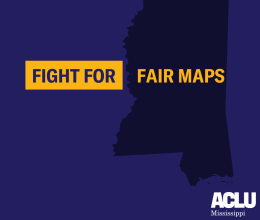
Fight For Fair Maps: Redistricting in Mississippi
July 26, 2021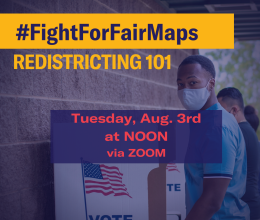
Fight for Fair Maps: Redistricting 101 Virtual Training
August 3, 2021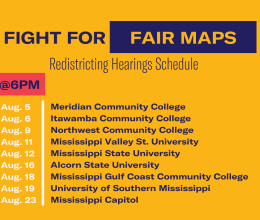
Redistricting Hearings Schedule
August 23, 2021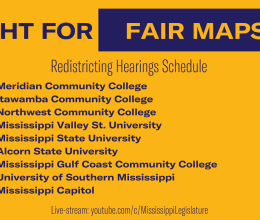
Legislators set public redistricting hearings, complete with live...
July 12, 2021
HB 871: Affidavit Ballot
January 24, 2025
HB 562: Voting Rights Restore to All
January 24, 2025
HB 1419: Polling Places
January 24, 2025